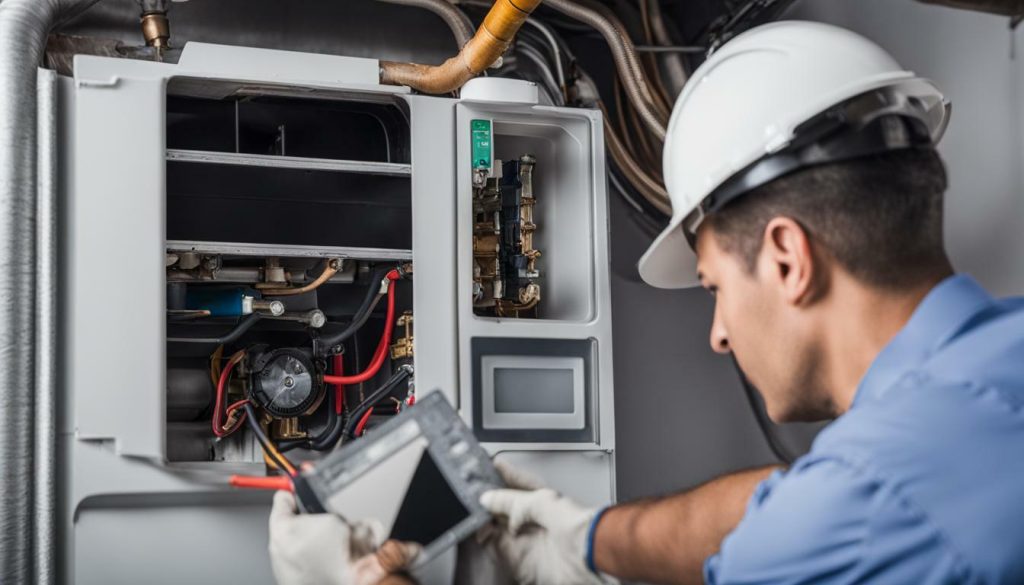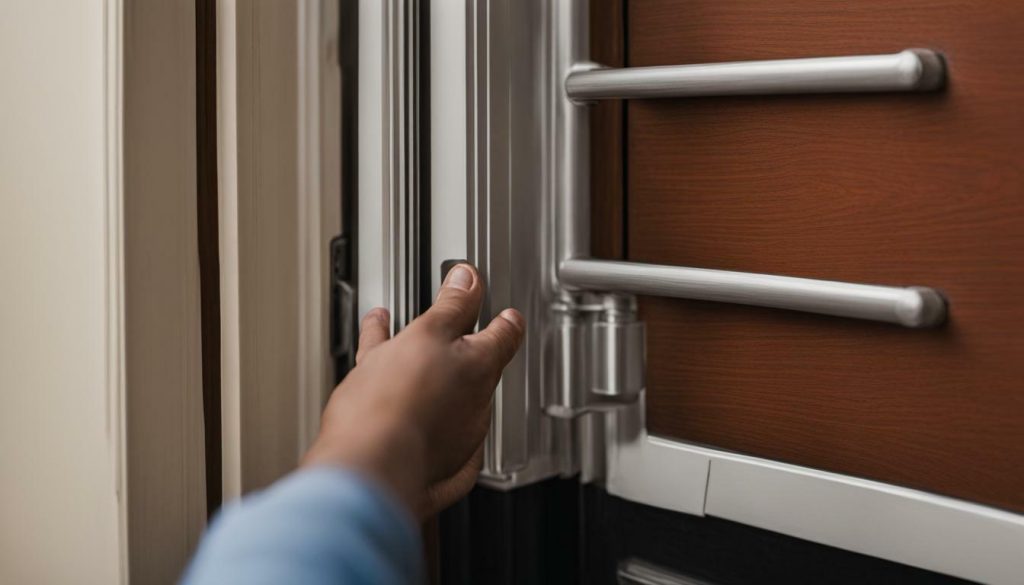Cross selling HVAC services is a valuable strategy for businesses looking to increase client value and enhance their offerings. By implementing effective cross selling strategies, HVAC businesses can not only boost their revenue but also strengthen customer relationships and maximize client satisfaction.
Key Takeaways:
- Understanding customer needs is crucial for effective cross selling of HVAC services.
- Transparency and ethical practices are essential when implementing upselling and cross selling strategies.
- Leveraging a digital proposal system, such as OnCall Air, can streamline and enhance cross selling efforts.
- Cross selling to existing customers is more cost-effective than acquiring new customers.
- The mere exposure effect can be leveraged to build trust and preference with customers.
Understanding Customer Needs for Effective Cross Selling
In order to successfully cross sell HVAC services, it is crucial to listen to your customers and identify their unique needs and preferences. By understanding what your customers are looking for, you can tailor your offerings to meet their specific requirements, increasing the likelihood of successful cross selling.
One effective strategy is to offer customers a limited set of choices that they can truly benefit from. For example, if a customer is interested in a new air conditioning unit, you can present them with various options that cater to their specific needs, such as energy efficiency, noise levels, or budget considerations. By presenting tailored options, you show your customers that you understand their needs and are able to provide solutions that address their concerns.
Listening to your customers is essential for effective cross selling. Take the time to ask probing questions and actively listen to their responses. This will not only help you identify their immediate needs but also uncover any potential long-term needs that you can address with additional services or products. By showing a genuine interest in your customers’ concerns, you build trust and establish yourself as a reliable source of HVAC solutions.
| Customer Needs | Strategies |
|---|---|
| Energy efficiency | Offer high-efficiency HVAC systems and explain the potential cost savings over time. |
| Indoor air quality | Suggest air purifiers or filtration systems to improve air quality and reduce allergens. |
| Zoning | Highlight the benefits of zoning systems for personalized comfort and energy efficiency. |
| Maintenance | Offer maintenance plans to ensure optimal performance and extend the lifespan of HVAC systems. |
By understanding your customers’ needs and tailoring your offerings accordingly, you can effectively cross sell HVAC services and increase client value. This not only enhances the customer experience but also strengthens your business relationships and drives revenue growth.

Transparency and Ethical Cross Selling Practices
Implementing an upselling or cross-selling strategy requires transparency and ethical practices, ensuring that customers understand the value of the additional products or services. By being transparent about the benefits and features of the upsell or cross-sell item, customers can make informed decisions that align with their needs and preferences. Ethical practices involve being honest and straightforward with customers, providing accurate information about pricing, warranties, and any potential limitations of the products or services.
One way to promote transparency is by offering clear and concise product descriptions that highlight the unique selling points of the upsell or cross-sell item. This can be done through informative content on your website, brochures, or digital proposal systems. Including images or videos that showcase the benefits and functionality of the product can also help customers visualize how it can enhance their HVAC system.
Table 1: Key Features of Cross-Sell Item
| Feature | Description |
|---|---|
| Energy Efficiency | Reduces energy consumption and lowers utility bills |
| Enhanced Comfort | Improves airflow and temperature control for optimal comfort |
| Advanced Technology | Integrates smart features for easy control and monitoring |
| Extended Warranty | Provides additional coverage for peace of mind |
Furthermore, it is essential to emphasize the added value of the upsell or cross-sell item to the customer. Highlight how it can enhance their HVAC system’s performance, improve energy efficiency, or provide additional features that align with their specific needs. Offering testimonials or case studies from satisfied customers who have benefited from the upsell or cross-sell item can also help build trust and credibility.
Ultimately, transparency and ethical practices not only instill confidence in customers but also contribute to long-term customer satisfaction and loyalty. By being transparent and ethical in your cross-selling efforts, you can build strong relationships with customers based on trust, integrity, and mutual benefit.

Leveraging a Digital Proposal System for Enhanced Cross Selling
By leveraging a digital proposal system like OnCall Air, you can make cross selling HVAC services easier and more efficient, providing customers with detailed information and convenient financing options. With this system, you can create professional proposals that showcase the value and benefits of your upsell or cross-sell items, helping customers make informed decisions.
OnCall Air allows you to present customers with interactive content, such as images, videos, and product descriptions, that highlight the features and advantages of your offerings. This visual presentation can greatly improve customer understanding and engagement, increasing the likelihood of a successful cross sale.
In addition to informative content, OnCall Air also offers financing options directly within the proposal. This streamlines the process for customers, allowing them to explore financing options and apply for credit right from the proposal itself. This convenience can remove barriers to purchasing and increase the chances of closing the sale.
| Benefits | Description |
|---|---|
| Increased customer engagement | Interactive content captures customer attention and encourages them to explore cross-sell options. |
| Improved understanding | Visual presentations and detailed descriptions help customers fully grasp the value and benefits of proposed items. |
| Convenient financing | Integration of financing options simplifies the purchasing process for customers, leading to higher conversion rates. |
| Streamlined proposal creation | A digital proposal system like OnCall Air allows for efficient creation and customization of proposals, saving time and resources. |
By utilizing a digital proposal system, you can enhance your cross selling efforts, making it easier for customers to understand the value of your offerings and increasing the chances of a successful sale. OnCall Air offers a user-friendly interface and convenient features that can revolutionize your HVAC service cross selling strategy.

The Cost-Effectiveness of Cross Selling to Existing Customers
Cross selling to existing customers is a cost-effective strategy that can yield higher returns compared to acquiring new customers, making it essential to understand customer needs and emotions. By focusing on upselling and cross-selling to your existing customer base, you can tap into a pool of customers who already trust and value your HVAC services. These customers are more likely to be receptive to additional offerings, resulting in increased sales and client value.
When implementing cross-selling strategies, it is crucial to understand the specific needs and wants of your customers. By listening to their feedback and identifying their pain points, you can tailor your upsell and cross-sell options to provide maximum value. Offering a limited set of choices that genuinely benefit your customers will help build trust and increase the likelihood of a successful cross sale.
Transparency and ethics play a vital role in the success of your upselling strategy. Clearly demonstrate the added value that the upsell or cross-sell item can provide, ensuring that customers understand how it complements their existing HVAC services. By being honest and transparent, you can build stronger customer relationships and enhance their overall experience with your business.
| Benefits of Cross Selling to Existing Customers |
|---|
| Higher conversion rates |
| Lower customer acquisition costs |
| Increased customer loyalty and satisfaction |
| Opportunity for long-term partnerships |
Implementing cross-selling strategies can be made easier and more efficient with the use of a digital proposal system like OnCall Air. This system allows you to provide customers with access to informative content about each upsell or cross-sell opportunity. Additionally, it offers the convenience of financing options, making it more enticing for customers to consider additional services or products.
By leveraging the cost-effectiveness of cross selling to existing customers, HVAC businesses can maximize their revenue potential and establish long-term customer relationships. Understanding customer needs, providing transparent and ethical recommendations, and utilizing digital tools are key factors in successfully implementing cross-selling strategies and increasing client value.

The Mere Exposure Effect and Building Trust
The mere exposure effect suggests that the more customers see your HVAC business and brand, the more they will trust and prefer your services. Consistent brand exposure is key to building trust and preference with customers. By consistently presenting your business and brand to potential clients, you increase the likelihood of them choosing your services over competitors.
To leverage the mere exposure effect, it is important to ensure that your brand is visible across various channels, including your website, social media profiles, and online directories. Consistency in messaging and visual identity will help reinforce your brand image and make it recognizable to customers.
A digital proposal system like OnCall Air can also play a significant role in building trust and preference. By providing customers with access to informative content about each product, including detailed specifications, benefits, and testimonials, you can help them make more informed decisions. Additionally, offering the option to apply for financing through the digital proposal system can make the upselling and cross-selling process easier and more convenient for customers.

Building Customer Relationships with the Foot-in-the-Door Technique
Utilizing the foot-in-the-door technique can help establish stronger relationships with customers by starting with small requests before presenting larger ones. This technique involves initially asking customers for a small commitment, such as signing up for a newsletter or attending a free webinar. By gaining their agreement to these smaller requests, you are more likely to receive a positive response when presenting larger offers or upsells in the future.
One way to employ the foot-in-the-door technique is by offering customers a complimentary service or consultation. For example, you could provide a free HVAC system inspection or offer a no-obligation estimate for a potential installation or repair job. By taking advantage of this opportunity, customers can experience firsthand the value and expertise your business provides.
To further enhance the foot-in-the-door technique, it is essential to demonstrate the benefits and advantages of the larger service or product you are proposing. Clearly communicate how it complements the initial request and aligns with the customer’s needs. By showing how the larger offer builds upon the initial commitment, you can increase the likelihood of customer acceptance and foster a stronger relationship.
| Benefits of the Foot-in-the-Door Technique | Implementation Tips |
|---|---|
|
|

By employing the foot-in-the-door technique, you can not only increase your chances of making a successful upsell or cross-sell but also build stronger customer relationships. Remember to start with small requests, demonstrate the value of larger offerings, and provide exceptional service throughout the customer’s journey. By implementing these strategies, you can effectively cross-sell HVAC services and ultimately increase client value.
The Door-in-the-Face Technique for Increased Conversion
The door-in-the-face technique can be an effective strategy for increasing conversion rates by presenting a large request before offering a smaller, more appealing option. This technique takes advantage of the human tendency to feel more inclined to agree to a smaller request after initially declining a larger one.
By starting with a larger request, such as a comprehensive HVAC maintenance package, you can create a perception of value and make the subsequent smaller request, like a routine maintenance appointment, seem more reasonable and desirable. This approach taps into the principle of reciprocity, as customers may feel more compelled to agree to the smaller request as a way of reciprocating after declining the larger one.
A study conducted by Cialdini and colleagues found that this technique significantly increased compliance rates compared to starting with the smaller request alone. This is because the contrast between the large and small requests creates a sense of concession, making customers more likely to agree to the smaller option.

Example: The Door-in-the-Face Technique in HVAC Sales
Let’s say you’re a HVAC technician offering a service contract to a customer. Instead of immediately presenting the service contract, you could start by offering a comprehensive whole-house HVAC system inspection at a higher price. After the customer declines, you can follow up with a smaller request to sign up for a basic service plan that covers routine maintenance visits throughout the year.
This approach not only increases the likelihood of converting the customer into a service plan subscriber, but also enhances customer satisfaction. By initially presenting a larger request and then offering a more affordable option, you’re able to demonstrate the value of the service plan while providing the customer with a sense of choice and control.
| Benefits of the Door-in-the-Face Technique |
|---|
| Creates a perception of value |
| Increases compliance rates |
| Utilizes the principle of reciprocity |
| Enhances customer satisfaction |
Leveraging the Reciprocity Principle for Customer Engagement
By understanding and leveraging the reciprocity principle, you can increase customer engagement by offering free services or estimates that create a sense of obligation to reciprocate. When customers receive something of value without expecting it, they feel compelled to return the favor. This principle can be a powerful tool in your cross-selling efforts.
One effective way to implement the reciprocity principle is by offering free services or estimates to potential customers. By providing them with something valuable at no cost, you create a sense of goodwill and obligation. Customers are more likely to reciprocate by engaging further with your business, such as making a purchase or recommending your services to others.
For example, you can offer a free HVAC system inspection or a complimentary consultation to assess their heating and cooling needs. This not only demonstrates your expertise and commitment to customer satisfaction but also establishes a sense of reciprocity. Customers will feel more inclined to reciprocate by considering your recommendations or choosing your company for future HVAC needs.
To effectively leverage the reciprocity principle, it’s important to communicate the value of the free service or estimate. Highlight the benefits and how it can address their specific needs. Emphasize that it’s a limited-time offer or an exclusive opportunity. This creates a sense of urgency and further enhances the perceived value.
Table: Comparative Benefits of Offering Free Services or Estimates
| Benefits | Impact on Customer Engagement |
|---|---|
| Creates a sense of obligation to reciprocate | Increased likelihood of customers engaging further with your business |
| Builds trust and goodwill | Establishes a positive impression of your business |
| Positions your company as a trusted expert | Increases the likelihood of customers considering your recommendations |
By leveraging the reciprocity principle and offering free services or estimates, you can not only increase customer engagement but also build trust and position your company as a trusted expert in the HVAC industry. Utilize this powerful tool to enhance your cross-selling efforts and drive customer loyalty.

Note: The image is for illustrative purposes only and represents the concept of the reciprocity principle in customer engagement.
Creating a Sense of Exclusivity for Increased Perceived Value
Creating a sense of exclusivity can significantly enhance the perceived value of HVAC products or services, making customers feel privileged to be a part of your offerings. By carefully crafting an exclusive experience, you can tap into the psychological desire for status and prestige, driving customer engagement and loyalty.
One effective way to create a sense of exclusivity is by offering limited edition or limited-time offers. This can be a special deal, a unique service package, or access to a premium membership program. By positioning these offerings as exclusive and available to only a select few, customers are more inclined to view them as valuable and desirable.
Another strategy is to leverage customer testimonials and success stories to showcase the exclusivity of your services. Highlight how your HVAC solutions have benefited top-tier clients or high-profile projects. By associating your brand with success and exclusivity, you can generate a sense of prestige and aspiration among customers.

In addition, hosting special events or exclusive gatherings for your loyal customers can further enhance the perceived value. These events can provide opportunities for networking, learning, and engaging with other industry professionals. By inviting customers to exclusive gatherings, you create a sense of belonging and reward their loyalty, strengthening the bond between your brand and their trust.
To summarize, incorporating exclusivity into your HVAC offerings can elevate the perceived value of your products and services. Whether through limited edition offers, customer success stories, or exclusive events, creating a sense of exclusivity ignites customer interest and fosters a deeper connection with your brand.
Setting High Expectations for Better Results
Setting high expectations for both your technicians and customers is essential for achieving superior cross selling results, ensuring professionalism and excellence in every interaction. When your technicians have a clear understanding of the objectives and standards to meet, they are more likely to perform at their best and deliver exceptional service. This not only enhances the customer experience but also increases the likelihood of successful cross selling.
To set high expectations for your technicians, provide them with comprehensive training and ongoing support. Equip them with the knowledge and skills necessary to effectively communicate the value of your HVAC services and products. Encourage a proactive approach in identifying cross selling opportunities and offer incentives for meeting or exceeding sales targets.
Equally important is setting high expectations for your customers. Clearly communicate the benefits and advantages of the HVAC services or products you are cross selling. Showcase success stories and customer testimonials to demonstrate the positive impact that your offerings have had on others. By instilling confidence in your customers and highlighting the value they stand to gain, you can increase their willingness to make a purchase.
| Technician Expectations | Customer Expectations |
|---|---|
| Thorough product knowledge | Clear understanding of benefits |
| Effective communication skills | Confidence in your offerings |
| Proactive approach to cross selling | Willingness to explore new options |
| Commitment to excellence | Trust in your expertise |
By setting high expectations for your technicians and customers, you create a culture of excellence and accountability. This fosters a positive and professional environment that is conducive to successful cross selling. Remember, when both parties are committed to achieving the best results, the potential for increased client value becomes limitless.

Guiding Customers with Strategic Pricing and Influence
Strategic pricing techniques, such as framing questions and utilizing the decoy effect, can help guide customers towards desired choices, while leveraging conformity can tap into social influence. When presenting pricing options to customers, framing the questions in a way that highlights the benefits and value of each choice can influence their decision-making process. For example, instead of asking, “Do you want the basic package?”, you can reframe the question to, “Which level of service best meets your needs?”. This subtle shift prompts customers to consider the value they will receive rather than simply choosing between options.
Another effective technique is the decoy effect, where a third option is introduced to influence the choice between two other options. By strategically pricing the third option to be slightly less desirable than the main option, customers are more likely to choose the main option. For instance, if you are offering two service plans, you can introduce a third plan that includes additional services and set the price higher than the main plan. This creates a perception of value for the main plan, making it more attractive in comparison.
Table: Service Plans Comparison
| Service Plans | Basic | Premium | Exclusive |
|---|---|---|---|
| Benefits | Essential maintenance | Extended warranty, priority service | All-inclusive, 24/7 support |
| Price | $99/month | $139/month | $189/month |
Furthermore, people tend to conform to what they perceive others to be doing. By creating an environment that suggests a consensus, conformity can be leveraged to guide customer choices. For example, testimonials or case studies from satisfied customers can provide social proof and influence potential buyers. Highlighting popular or recommended products or services can also tap into the power of conformity.
By incorporating these strategic pricing techniques and leveraging conformity, HVAC businesses can effectively guide customers towards desired choices and increase the likelihood of upselling and cross-selling success.

Conclusion
By effectively implementing cross-selling strategies, HVAC businesses can not only increase client value but also achieve greater success in the highly competitive market. There are several key strategies to consider when cross-selling HVAC services.
First and foremost, it is important to offer customers a limited set of choices that truly benefit them. By listening to customers and identifying their needs, businesses can provide relevant upsell and cross-sell options that meet those specific requirements.
Transparency and ethical practices are essential in implementing upselling strategies. It is crucial to demonstrate the added value that the upsell or cross-sell item can provide, ensuring customers feel informed and empowered in their decision-making process.
Leveraging a digital proposal system, such as OnCall Air, can greatly enhance cross-selling efforts. This platform provides customers with access to informative content about each product or service and the convenience of applying for financing, making it easier for them to explore and consider their options.
Furthermore, focusing on existing customers for cross-selling can be a more cost-effective approach compared to acquiring new customers. Understanding customer needs and appealing to their emotions are key factors in driving cross-selling success. Implementing the mere exposure effect, the foot-in-the-door technique, and the door-in-the-face technique can help build stronger customer relationships and increase conversion rates.
The reciprocity principle can also be leveraged by offering free services or estimates, which generates a sense of obligation to reciprocate and engages customers further. Creating a sense of exclusivity can increase the perceived value of HVAC products or services, while setting high expectations for both technicians and customers can drive better cross-selling results.
Additionally, utilizing strategic pricing techniques, framing questions, and leveraging the decoy effect can guide customers towards desired choices and influence their decision-making process.
In conclusion, by implementing these strategies, HVAC businesses can effectively cross-sell services and increase client value, ultimately leading to greater success in the highly competitive market.
FAQ
What strategies can be implemented to cross-sell HVAC services and increase client value?
Some effective strategies include offering customers a limited set of choices that they can benefit from, listening to customers and identifying their needs, being transparent and ethical in the upselling process, demonstrating the added value of the upsell or cross-sell item, and leveraging a digital proposal system like OnCall Air.
Why is cross selling to existing customers more cost-effective than acquiring new customers?
Cross selling to existing customers is more cost-effective because the business already has a relationship with them, and they are more likely to trust the brand. Acquiring new customers requires additional marketing and sales efforts, which can be more expensive.
How can the mere exposure effect be utilized to increase trust with customers?
The mere exposure effect suggests that the more customers see your business and brand, the more they will like and trust you. Consistent brand exposure through marketing and advertising can help build trust and preference.
What is the foot-in-the-door technique and how can it be used to build stronger customer relationships?
The foot-in-the-door technique involves starting with small requests before making larger ones. By gradually building a bond with customers and gaining their trust through small interactions, businesses can establish stronger customer relationships and increase the likelihood of upselling or cross-selling.
How can the reciprocity principle be leveraged to increase customer engagement?
The reciprocity principle states that when something is done for a customer, they feel inclined to do something in return. By offering free services or estimates as a gesture of goodwill, businesses can generate a sense of reciprocity and increase customer engagement.
What is the importance of creating a sense of exclusivity in cross-selling efforts?
Creating a sense of exclusivity can increase the perceived value of an item. By positioning certain products or services as exclusive or limited edition, businesses can tap into customers’ desire for unique offerings and increase their willingness to purchase.
Why is setting high expectations important for both technicians and customers?
Setting high expectations for both technicians and customers can lead to better cross selling results. When technicians strive for professionalism and performance excellence, they deliver higher-quality service, which enhances customer satisfaction and increases the likelihood of cross-selling success.
How can strategic pricing techniques and influence guide customers towards desired choices?
Strategic pricing techniques, such as framing questions and utilizing the decoy effect, can help guide customers towards certain choices. Additionally, leveraging conformity, which suggests that people are influenced by what they perceive others to be doing, can further shape customer decision-making.





0 Comments